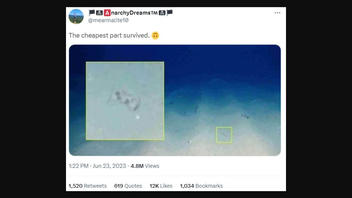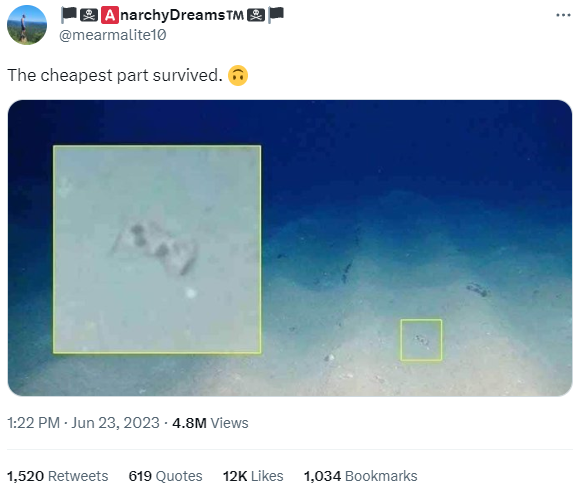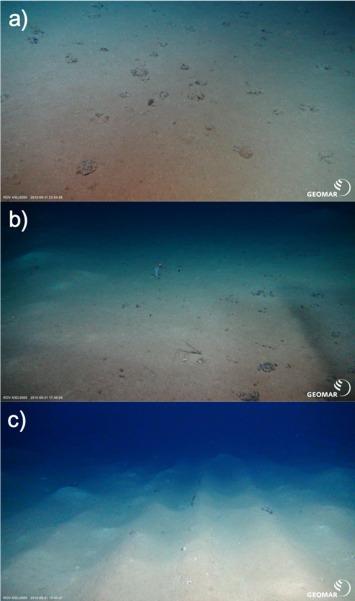STORY UPDATED: check for updates below.

Does this photo show the controller belonging to OceanGate's Titan on the seafloor after the submarine vessel suffered a "catastrophic implosion" while descending to the wreckage of RMS Titanic? No, that's not true: An image shared on social media that claimed to show the "cheapest part" of the vessel having "survived" was, in fact, an altered version of a photograph originally published in 2020 as part of a study researching the effects of deep-sea mining. The German ocean and atmospheric research organization GEOMAR confirmed to Lead Stories that the original image was captured by a remotely operated vehicle (ROV) in 2015. Also, the U.S. Coast Guard told Lead Stories that "no imagery of the wreckage has been released," as of June 27, 2023.
A version of the claim originated in a post shared to Twitter on June 23, 2023, (archived here). A caption that accompanied the photo read:
The cheapest part survived. 🙃
Below is how the post appeared at the time of writing:
(Source: Twitter screengrab captured Fri June 23 18:34:00 UTC 2023)
The above post was shared on Twitter following the June 22, 2023, announcement that the Titan suffered a "catastrophic loss of the pressure chamber."
In an email to Lead Stories received June 27, 2023, the U.S. Coast Guard stated that "no imagery of the wreckage has been released" by the agency.
Using a reverse image search, Lead Stories traced the image to 2020, when it was originally published as part of a scientific study researching the impacts of deep-sea mining on the seafloor. The study, titled "Abyssal food-web model indicates faunal carbon flow recovery and impaired microbial loop 26 years after a sediment disturbance experiment," was published in the scientific journal Progress in Oceanography (archived here).
GEOMAR confirmed that the image was taken prior to the 2023 Titan accident.
"It [was] taken by our Remotely Operated Vehicle ROV Kiel 6000 in 2015 during expedition SO242 in the Peru basin, Pacific Ocean, in the context of the MiningImpact project," a spokesperson confirmed to Lead Stories in an email received June 27, 2023.
Below is how the image originally appeared in the study:
(Source: Progress in Oceanography)
A caption that accompanied the original image read:
Fig. 1. Representative pictures of the sediments at (a) reference sites, (b) outside plough tracks, and (c) inside plough tracks taken during the Sonne SO242-2 cruise to the DISCOL site in 2015. Photos by ROV Kiel 6000 (GEOMAR, Kiel, Germany).
The study was conducted by an international team of scientists who investigated how deep seafloor ecosystems were impacted by "disturbances such as those caused by mining activities."
The tracks featured in the image were taken in 1989 when German researchers simulated mining-related disturbances in a manganese nodule field 2½ miles below the ocean surface by plowing a more than 2-mile-wide area of the seabed.
According to the study, the photograph was captured at a location known as the DISCOL area in the tropical East Pacific about 1,900 miles off the coast of Peru.
The same image was also published in EOS, the American Geophysical Union scientific magazine, on May 21, 2020, (archived here) in an article titled, "The Long-Lasting Legacy of Deep-Sea Mining" and by the BBC (archived here) in December 2020.
Lead Stories has also reported that a social media post did not include an authentic recording of sounds reportedly detected near the Titan search zone, that the "missing OceanGate submarine" was not "found empty" at the bottom of the Atlantic Ocean and that the submarine vessel was not rescued with all five of its missing passengers alive.
Updates:
-
2023-06-27T18:56:36Z 2023-06-27T18:56:36Z Adds quote from U.S. Coast Guard. -
2023-06-27T18:03:54Z 2023-06-27T18:03:54Z Adds quotes from GEOMAR.



















